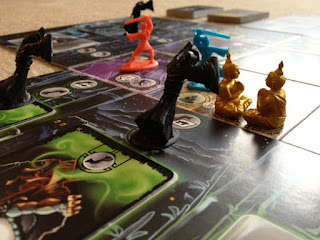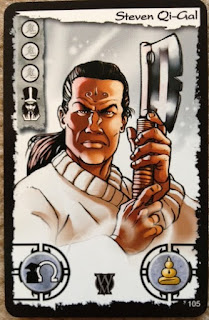One of my friend's favorite co-operative games is Ghost Stories; so I took the opportunity to play it.
In Ghost Stories, you take on the role of a Taoist priest that is fighting (along with three other priests) to excise Wu Feng from the world. Unfortunately, Wu Feng has legions of ghostly minions, which are terrorizing you and your village. Each turn, the active player reveals a ghost from the deck and places it on the board. Next, they can move one space and take that space's action (if it has not been haunted). Some of the actions include reviving a dead priest, rolling dice to gain more tao tokens, setting up a universal tao token that can be used in every fight, pushing ghosts away from the village, unhaunting village tiles, etc. Conversely, instead of utilizing a space's action, you may choose to attack any adjacent ghosts. Each ghost has a color and a strength. In order to excise him, you roll three dice (and potentially add tao tokens). If between the dice and your tao tokens you have enough strength in the ghost's matching color, then he is discarded. Eventually, Wu Feng will emerge from the deck (if you don't die first). If you are able to successfully defeat him before you all die or your village becomes especially haunted (you know - that time in a village's life when even the wind seems like it is whispering ghastly ramblings into your ear; oh - I mean three village tiles are haunted), then you win!
My first pro for Ghost Stories is that it does an amazing job of providing a feeling of "optimistic doom." By this, I mean that you feel like you're going to lose. From round one. Yet, as the game progresses and you continue holding off your loss, you start to get the impression that you have a chance. I doubt that you will ever feel like you just dominated a game of Ghost Stories. Instead, you will constantly be balancing how you're going to keep your team just barely alive. This might be by sacrificing a team member periodically to destroy an especially strong ghost, or it might be in pushing ghosts back for one more turn so that one of your fellow priests will have a chance to attack before being haunted. What you do will never be enough to completely defeat the ghosts - but it may allow you to survive long enough to defeat Wu Feng!
 |
| It never hurts that it looks awesome |
The third pro I have for Ghost Stories is that I like how the die rolling is implemented. When attacking a ghost, you roll the dice to see if you defeat them. Any die roll that matches their color (or is white, which is wild), counts as a hit. However, many ghosts have three or four hitpoints - which is very hard to defeat when you're only rolling three dice. This is when tao tokens come into play. Your priest can collect tao tokens (and there can be a universal tao token), and these tao tokens can be contributed towards your battle, thus counting as additional hits on the adjacent ghost(s). This means that there is a random element in the game, but you can still mitigate the chances of getting frustrated by the dice. And, occasionally you will even roll exceedingly well, thus keeping all of your tao tokens (for next time - because there will definitely be a next time).
Since no game is perfect, Ghost Stories has a couple cons that I feel are worth mentioning. First, I think that bad luck can really make the game too overwhelming. I already mentioned how the die rolling works, and how luck is somewhat mitigated when attacking ghosts. Yet, sometimes the dice will completely defy the odds and you will lose an attack that you would win 99 out of every 100 times. Yet, that's not really what I mean. Where I think that bad luck can be too powerful is when rolling the curse die and drawing ghosts. The curse die has two blank faces, and four awful faces. The different rolls can cause you to haunt a space, lose all of your tao tokens, lose a life point, or draw and place a new ghost. Some of these things can instantly cost you the game (the others might make you lose, but more slowly). Similarly, when drawing ghosts, some of the ghosts cause you to draw another ghost. If several of these are drawn in a row, then you can instantly go from surviving fairly well to being slaughtered by the game. With any game that has random elements to it, luck can help you or hurt you. But, though Ghost Stories mitigated the luck of die rolling when attacking, I wish they had mitigated the curse die a bit more. (The different things that can be rolled are why you really want the priest that can ignore the curse die to take as many of the curses as possible.)
 |
| Good luck with these icons. |
One last thing that I will mention about Ghost Stories (not really a pro or a con) is that it is only a four player game. The box says 1-4, and there are rules for playing with less than four, but, ultimately, the entire game was designed for four. The very setup of the game is dependent on having four player boards, and if less than four people are playing, then you will have each board activate, just like in a four player game. There's nothing wrong with a game that requires a specific number of players, and you even can play this with less. But, if you have a choice, I would recommend playing this with four so that you can avoid extra rules that work around you having less players.
Overall, I give Ghost Stories an 8.5/10. Though it isn't my favorite cooperative game, it is still a highly enjoyable experience. If the theme doesn't bother you, then you should definitely try it out. (And, as an added bonus, Ghost Stories has several promotional Wu Feng cards that are puns. Like "Chuck No Rice" and "Steven Qi Gal". And, puns are wonderful!)
If you are looking for more cooperative games, you should also check out Lord of the Rings, Shadows Over Camelot, and Forbidden Island.



0 komentar:
Posting Komentar